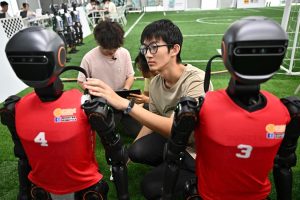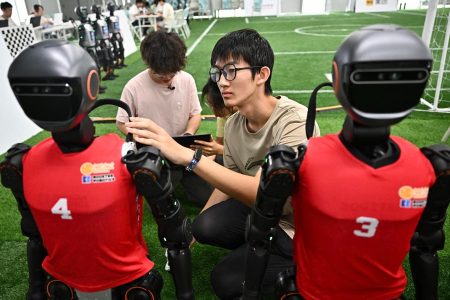Bethlam Forsa is CEO of Savvas Learning Company, a global next-generation learning solutions provider for K-12 education.
When OpenAI introduced ChatGPT to the world, it generated massive public interest. The artificial intelligence (AI) tool became the fastest-growing consumer software application in history.
At the same time, it sparked widespread controversy. Critics feared its harmful effects on humanity while school districts banned it out of concern it could help students cheat. And it kick-started an arms race among tech giants. Google, Meta, Amazon and Microsoft fast-tracked the development of their own competing products.
Today, it’s clear that many industries will be impacted by the growing popularity of AI and its potential to increase productivity. The K-12 education sector is certainly among them, and this couldn’t happen at a more critical time.
As we’ve emerged from a historic pandemic, the nation’s education system is still grappling with its aftermath. Teacher burnout continues to dwindle the ranks of overworked educators, causing troubling teacher shortages. Meanwhile, after years of disrupted learning, students’ achievement on national math and reading tests has dropped to historic lows.
Developing tools to make teachers’ jobs easier by automating certain tasks could present an opportunity to revitalize teaching, increasing job satisfaction and attracting more teachers. By making learning solutions even more adaptive to the needs and learning styles of individual students, AI could provide a more equitable approach to K-12 education while helping to advance learning.
The capabilities of generative AI, such as its ability to interpret and generate human-like text, offer many promising scenarios for its use in K-12 education. It could serve as a teacher’s “assistant,” helping draft lesson plans and quizzes or auto-scoring assignments, performing administrative tasks that free up teachers to spend more time interacting with students.
Personalizing Learning, At Scale
Over the past decade, education companies have incorporated AI-powered capabilities in some of their digital solutions to create adaptive learning experiences. With the advent of more sophisticated generative AI, many of these companies are now actively researching ways to develop AI-assisted intelligent tutors, dubbed “tutorbots,” that can provide instant feedback and explanations customized to learners’ unique needs and interests.
Picture a writing coach that can give students real-time guidance and critiques to improve their writing skills. AI tools like speech recognition could also be used to support students learning to read as well as multilingual learners and those with learning differences. Providing students with deeply personalized learning experiences, tailored to their individual learning styles at scale, is one of the most promising benefits of machine learning. If students can be assisted by digital tutors providing feedback on their work and addressing their questions, teachers can better focus on those most in need of support. This will be truly game changing.
While undoubtedly transformative, the piloting of an AI chatbot in Newark, New Jersey classrooms offers a cautionary tale of new technology that might not quite be ready for prime time, at least when it comes to the most important user base one can think of—impressionable young minds.
Ensuring AI Has a Clear Purpose
Before any AI-assisted learning tools end up in front of students, there are many fundamental questions that need to be addressed. First, is it the right tool for the job and does it have a sound pedagogical purpose, one with a clear benefit that enhances teaching and learning? Second, is the AI being implemented in a safe, responsible and thoughtful way that protects students’ online safety and data privacy? Third, have steps been taken to test the quality of the underlying data used to build the AI model, and have algorithmic biases that can lead to unintended discrimination been mitigated? Lastly, does the AI ensure “humans are in the loop” so that the technology never replaces the teacher as the one responsible for overseeing the students’ instruction?
Once all of these concerns have been met, education companies must then make certain the content that generative AI models produce is accurate and the models’ current tendency to drift, “hallucinate” and invent facts is eliminated. The case of the lawyers sanctioned for submitting a brief with fictitious legal cases blamed on ChatGPT demonstrates that these early forms of generative AI technology are sometimes unreliable and still require careful review of the content they generate.
Education companies can’t afford to get AI wrong. If we roll out tutorbots that provide students with nonsensical information or spoon-feed them the answer instead of guiding them to an answer (such as in the way a teacher, using the Socratic method, asks probing questions to develop grit and critical thinking skills in a student), then we risk losing the trust of educators.
The Walled Garden Approach
Today’s curriculum providers have the foundation for creating AI-enabled learning tools that provide more reliable information. Instead of using large-language models trained only on content from the internet, we have the ability to train generative AI models on our own intellectual property: thousands of digital textbooks, from math and literacy to humanities and science programs, used in classrooms. This approach of a walled garden—a closed environment that limits students’ access to open content—should greatly reduce the AI models’ propensity to hallucinate or stray off subject.
We want educators to embrace AI-assisted learning, not fear it. For this to happen, AI technology built into curriculum and assessment products must be used responsibly and effectively, with clear guardrails that prioritize safety, integrity, accuracy and efficacy, above all else. If we succeed at that, teachers will appreciate the benefits that AI can offer in helping to personalize learning like never before.
Before we add new technology, AI or otherwise, to K-12 learning solutions, we must ensure we are keeping teachers and students at the center of everything we do. Teachers and their expertise are irreplaceable, and their personal connections with their students cannot be matched or mimicked by a machine. Technology is a powerful tool that can support teaching and learning, but it’s still the teacher who makes the magic happen in the classroom.
Forbes Technology Council is an invitation-only community for world-class CIOs, CTOs and technology executives. Do I qualify?
Read the full article here








